#oligocene
Text
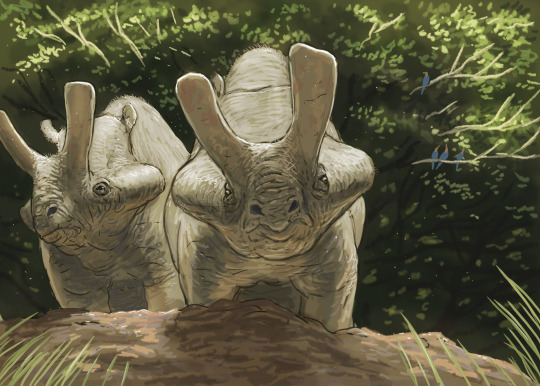
Another #paleostream sketch
Bronotheres and underrated creatures, look how goofy Megacerops for example is in frontal view.
1K notes
·
View notes
Text
A Brief History of Flamingos
People wanted it so here it is, a brief rundown of flamingos throughout prehistory, which is essentially a brief summary of extinct flamingo species that I worked on for Wikipedia.
Because of this, I'll stick to the two main famillies, the Palaeolodidae ("swimming flamingos") and Phoenicopteridae (true flamingos) and leave aside the misc. early forms we don't know are actually related or not.
Palaelodidae
Palaelodids, occasionally referred to as "swimming flamingos" are an interesting and surprisingly long lasting group, containing 3 genera, 10 species and ranging from the Oligocene to the Pleistocene across all continents bar Africa and Antarctica.
The oldest palaelodid is Adelalopus hoogbutseliensis from the Early Oligocene of Belgium. Not much to be said other than that its name is an anagram of Palaelodus.
Palaelodus is the most widespread of the genera in the family, with the type species being Palaelodus ambiguus from the Oligocene and Miocene of Europe. I did actually make a whole post about the genus before here. Anyways, P. ambiguus is the best known species thanks to the ample material collected at Saint-Gérand-le-Puy, France. Remains were also found in Germany and maybe Brazil?
Brazil is interesting, because already by the Oligocene palaelodids were nearly cosmopolitan. Two other species, Palaelodus pledgei and Palaelodus wilsoni, have been recovered from the Oligocene to Miocene of Australia, half a world away from P. ambiguus. P. pledgei is the smallest known species of Palaelodus.
During the early Miocene we also get Palaelodus aotearoa, from New Zealand, and from the middle Miocene Palaelodus kurochkini from Mongolia. The later of the two may in fact be its own genus, but for now its deemed Palaelodus.
Generally, Palaelodus is less specialised than flamingos, though living in brackish waters and feeding on small aquatic insects, they didn't yet have the same suffisticated filter feeding bill as todays flamingos. Whats debated is how they moved. Some suggest wading, others diving and again others propose the idea that they may have been swimmers.
There is one more note on this group, which is that there are some remains assigned to P. wilsoni that appear to have been Pleistocene in age? Obviously this would be a massive deal, but it has also been suggested that this could be a new species given the time gap or a whole new genus. Still, palaelodid remains from the Pleistocene are still incredible.
Palaelodus by Alphinyx and Tom Simpson


The last member of the Palaelodidae is Megapaloelodus. Yes they misspelled Palaelodus in the genus name. The definition of this form is kinda vague and mostly based on size, which is why there's so many issues around Megapaloelodus goliath. You see it was initially described based on its size, but when larger remains of Megapaloelodus were found it was transferred to that genus. However, all other Megapaloelodus species are from the Americas, so thats kinda odd, although of course not a dealbreaker. Still, future research might change things up here.
While Megapaloelodus goliath was contemporary and found at the same place as Palaelodus ambiguus, all others are found in Miocene to Pliocene deposits of America.
Megapaloelodus connectens is the type species and known from the Miocene of South Dakota and California.
Megapaloelodus peiranoi may be the basalmost species and was discovered in Miocene deposits of Argentina.
Finally, we got Megapaloelodus opsigonus from Oregon and possibly Baja California. As this is the youngest species, from the Pliocene, its name means "born in a later age".
Megapaloelodus by Joschua Knüppe (with Argentavis) and Scott Reid

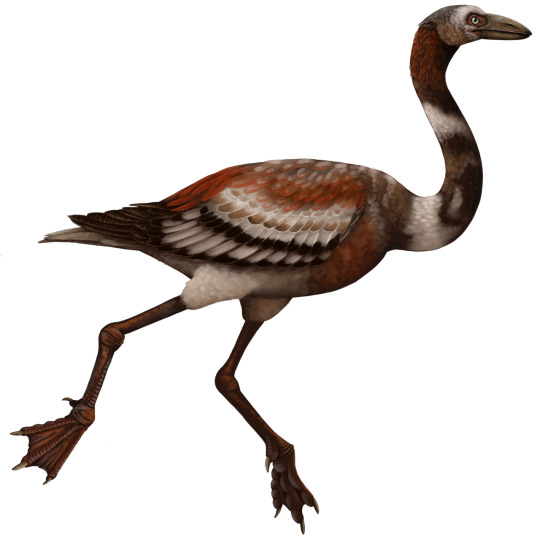
Which actually wraps up palaelodids. Yeah the majority of studies are focused on palaelodids, no surprise given its the only one with really good remains. But based on said animal, its a fascinating group.
This means we can move on to true flamingos, members of the family Phoenicopteridae. I hope you like that name btw, because goddamn "Phoenico" is an overused prefix for these animals to a ridiculous degree. Even I struggled keeping up.
Just to set the stage, lets establish the modern flamingos, split into two to three genera. There is the Lesser Flamingo (Phoeniconaias minor), the only extant member of its genus and native to Africa and Asia. There are two species of Phoenicoparrus, the Andean and Jame's flamingos (Phoenicoparrus andinus and Phoenicoparrus jamesi respectively), both endemic to South America. And then there's the three species of Phoenicopterus. The incredibly whidespread Greater Flamingo (Phoenicopterus roseus), the American Flamingo (Phoenicopterus ruber) and the Chilean Flamingo (Phoenicopterus chilensis). As if the Greater and American flamingos didn't already have latin names way too similar, they were also synonyms for a while so thats fun when they get brought up in old papers.
Chart of living flamingos by Mr. Gharial

Anyways, lets reset to the Oligocene and do this semi-chronologically as before. And yes, Oligocene. Because contrary to what you might think, palaelodids, as we currently think of them as, aren't the ancestors to flamingos and more a really weird sister group that appeared from the same common ancestor aroundt he same time.
Thankfully, we get to start with something fun and not confusing, Harrisonavis croizeti. Another one I did actually cover in detail on Tumblr right here. The short of it is that Harrisonavis already bears the hallmarks of modern flamingos, possessing that classic curved bill and certainly doing some filter feeding already. And if you paid attention you might recognize where its from. Saint-Gérand-le-Puy, France. Yup, this guy coexisted with Palaelodus and Megapaloelodus. Must have been a fascinating place.
Harrisonavis and Palaelodus by Joschua Knüppe

Of course this being a well known form, we gotta follow it up with something bad. Elornis is, simply put, a mess. We aren't even super sure if its a flamingo or not and its history is convoluted. All we can say for sure is that it lived during the late Oligocene in France.
Like palaelodids, true flamingos seem to have dispersed rapidly, as our next entry managed to reach Australia by the late Oligocene. Phoeniconotius eyerensis, I repeat that one, PhoenicoNOTIUS (you see what I mean with things getting confusing?) is a genus from the Lake Eyre Basin of South Australia. It was a comparably robust animal, much more massive than other flamingos and perhaps more of a wader than a swimmer, staying away from deeper waters?
Same time same place we got Phoenicopterus novaehollandiae. PhoenicoPTERUS, as in the same genus as American and Greater flamingos. Now this guy sticks mostly to the same stuff as its relatives, thus differing clearly from Phoeniconotius.
Phoeniconotius (foreground), Phoenicopterus novaehollandiae (?, middle) and palaeolids (background) by Frank Knight, Phoeniconotius by Anne Musser


We can now move into the Miocene. We get a brief break from Phoenico names courtesy of Leakeyornis aethiopicus from Kenya. Tho its not super well preserved, its among the few fossil flamingos with known skull remains, so thats gotta count for something.
Skeletal by me, art by Joschua Knüppe
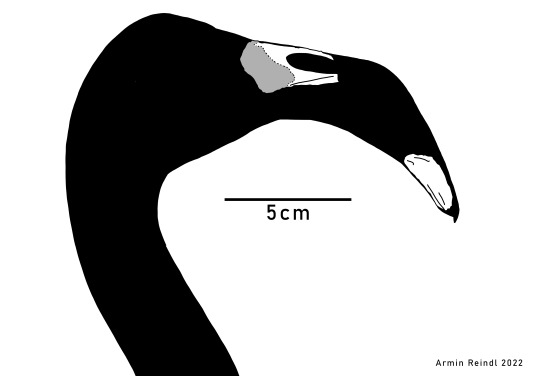
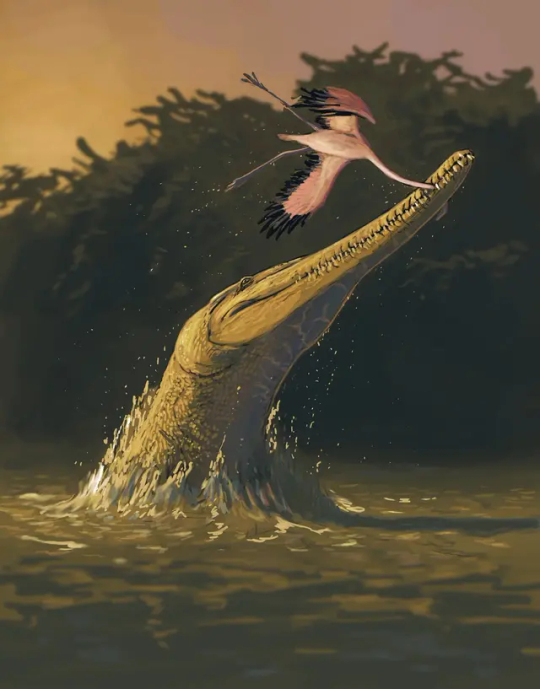
Also during the Miocene, we get the appearance of the genus Phoeniconaias (PhoenicoNAIAS) thanks to Phoeniconaias siamensis. A small species, only slightly larger than today's Lesser Flamingo, its remains are exclusively known from the Mae Long Reservoir in northern Thailand.
Fossil material of P. siamensis alongside a Lesser Flamingo via เบิร์ดโบราณ - Ancient bird on Facebook
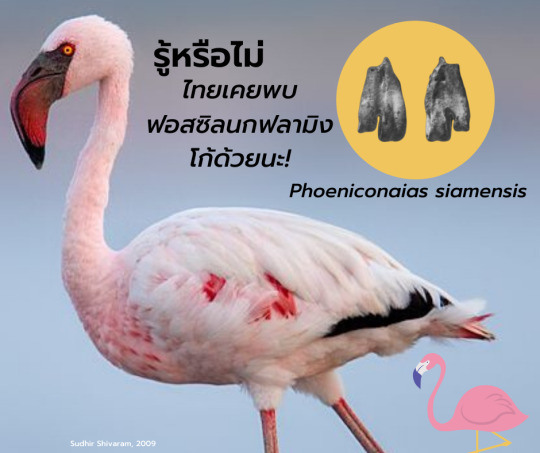
And already we find ourselves in the Pliocene. Oh how time flies. Lets wrap up known fossil species of Phoeniconaias then while we're at it. Phoeniconaias proeses is a species from Australia. Unlike our friend from Thailand, this one is actually smaller than its modern relative. It also coexisted with two other flamingos. Fossils from the region have been assigned to the Greater Flamingo and one other form we'll cover next.
Xenorhynchopsis. Our last truly original name. Xenorhynchopsis minor is the older of the two, Pliocene in age and the species I just alluded to earlier. The genus then went on to continue into the Pleistocene via Xenorhynchopsis tibialis. Neither is especially well known and both had been named by de Vis, who while no doubt an important contributor to Australian paleontology also had plenty of flaws I'll discuss soon with my next post on mekosuchines. Anyways, Xenorhynchopsis has a cool name, a confusing history (they were described as storks) and likely died out when the inland waterways of Australia dried up.
Its all downhill from here folks. It's all PhoenicoPTERUS from now on and none of them are especially good. Lets rewind to the Pliocene to cover them properly.
We got Phoenicopterus floridanus from the early Pliocene of, who guessed it, Florida. It may have also inhabited North Carolina.
Phoenicopterus stocki, or Stock's Flamingo, lived during the middle Pliocene in Mexico. Tho not well described, we got juvenile remains too, young individuals that were not yet capable of flight.
Finally we got two Pleistocene species.
Phoenicopterus minutus from California, specifically Lake Manix. Lake Manix also yielded fossils tentatively assigned to the other Pleistocene fossil species.
Phoenicopterus copei. While fossils of P. minutus are currently exclusive to Lake Manix, P. copei was more widespread, ranging from Mexico in the south to Oregon in the north as well as California in the west and Florida in the east. Where it coexisted with other flamingos, like P. minutus and American flamingos, it would have been the larger species.
And thats it. All the fossil flamingos of the Palaelodidae and Phoenicopteridae. Alas, bird fossils preserve notoriously poorly and though stuff like the ends of tibiatarsi and tarsometatarsi are diagnostic, they aren't super helpful to making them sound interesting to the average joe. So sorry if this whole post is a little dry in spots.
#palaelodidae#phoenicopteridae#palaelodus#megapaloelodus#adelolepus#leakeyornis#harrisonavis#elornis#phoenicopterus#phoenicoparrus#phoeniconaias#phoeniconotius#xenorhynchopsis#palaeoblr#paleontology#prehistory#oligocene#miocene#pliocene#pleistocene#cenozoic#flamingo#phoenicopteriformes#long post
158 notes
·
View notes
Text
Astorgosuchus, the Giant from the Bugti Hills

Astorgosuchus bugtiensis ( formerly Crocodilus bugtiensis ) was a large basal Crocodyloid from the Oligocene of Bugti Hills in Pakistan. There are only 3 specimens described, which includes a fragmentary rostrum and 2 fragmentary dentaries. The specimen reconstructed here is NHMUK R.5266, a missive fragmentary dentary.
The reconstruction of the mandible is based on Asiatosuchus germanicus, a basal Crocodyloid. This results in a mandible length of 156 cm which makes it a contender for the largest Crocodyloids and the largest Crocodylians ever. They were apex predators of the region and preyed on a variety of animals including Paraceratherium, Rhinoceros and Chalicotheres.
References:
Martin et al., (2019). A large crocodyloid from the Oligocene of the Bugti Hills, Pakistan
#astorgosuchus bugtiensis#astorgosuchus#crocodile#croc#crocodilian#crocodilia#crocodylomorpha#pseudosuchia#fossil#paleontology#skeletal#oligocene#pakistan#size comparison#paleoart
74 notes
·
View notes
Text

During the Rupelian (older Oligocene age), the area I live in was a shallow sea (in some places you can find small fossil seashells and stuff), so I thought it would be cool to draw it
100 notes
·
View notes
Text
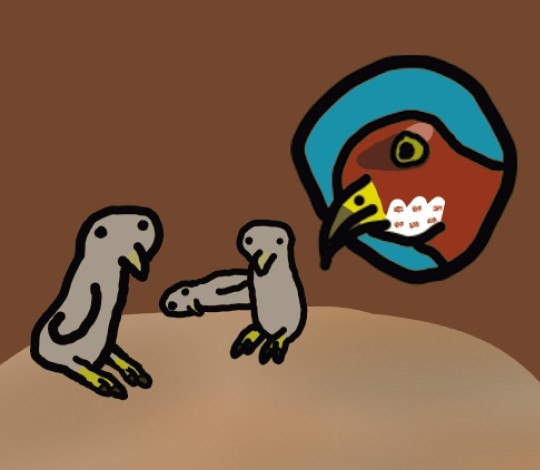
Fossil Novembirb: Day 14
A mother Aviraptor and her chicks
36 notes
·
View notes
Text
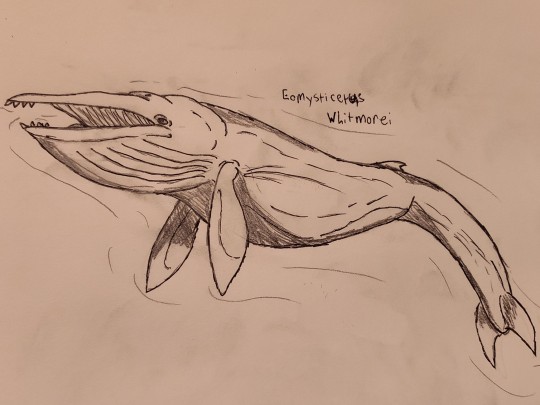
Eomysticetus (dawn baleen whale) was a mysticete that lived around 25 million years ago, and was discovered in South Carolina. Much like Aetiocetus, this whale had both teeth and baleen, although its baleen were much more prominent, and its teeth were likely vestigial. It most likely primarily utilized filter feeding like modern baleen whales, gulping loads of water and filtering microorganisms from the water. Bulk feeding in this way would prove to be a useful adaptation and would allow these creatures to get absolutely massive.
#eomysticetus#paleoart#paleontology#evolution#baleen whale#whales#whale evolution#whale#cetacean#cetaceans#oligocene#paleogene
19 notes
·
View notes
Text

Paraceratherium, one of the largest known land mammals. Growing around 15-17 feet at the shoulder, and weighing up to 15 to 20 tons, this extinct rhino relative was about the height of a giraffe, and was double the mass of an elephant.
#paraceratherium#paleoart#paleontology#oligocene#paleogene#mammal#cenozoic#extinctmammal#extinctspecies#rhino#digitalart#krita
30 notes
·
View notes
Text
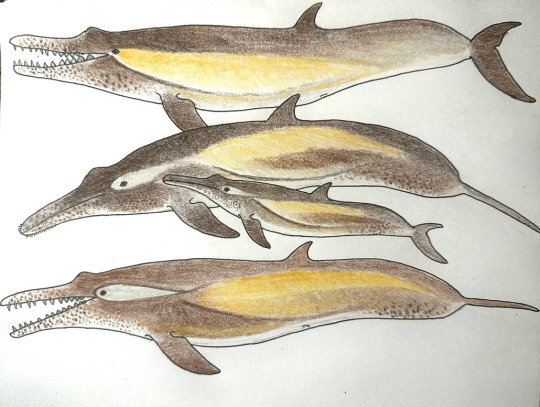
Impressions of the species of the basal baleen whale Coronodon from the Oligocene of South Carolina, from bottom to top: C.havensteini, C.planifions at center and C.newtonorum at the top. The latter two were just described a couple of months ago.
References:
32 notes
·
View notes
Text

Day 18: Squalodon calvertensis
A extinct genus of whales of the Oligocene and Miocene epochs, belonging to the family Squalodontidae.
#my art#paleoart#myart#my drawings#mammals#cetacean#squalodon#oligocene#miocene#cenozoic#toned tan#sketchbook
10 notes
·
View notes
Text
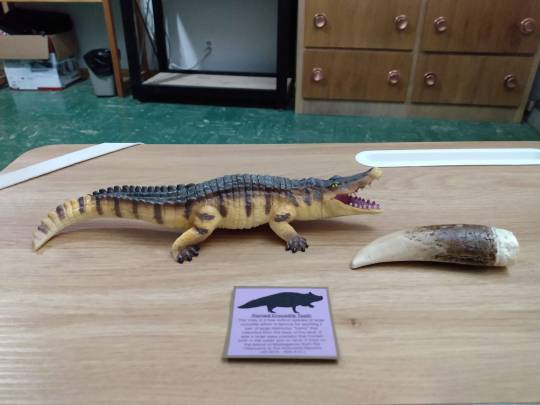



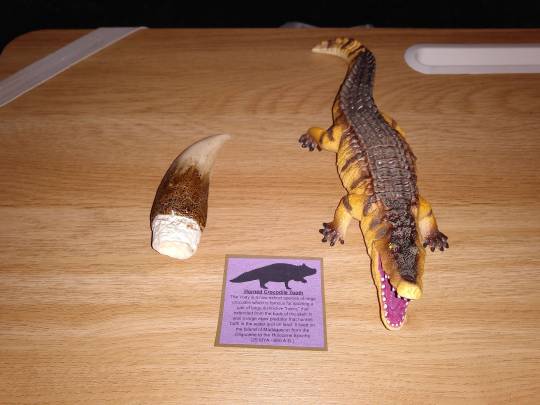

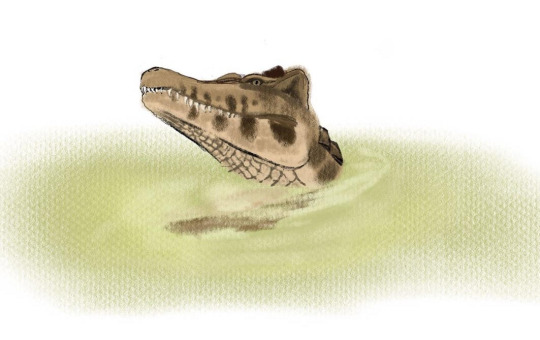

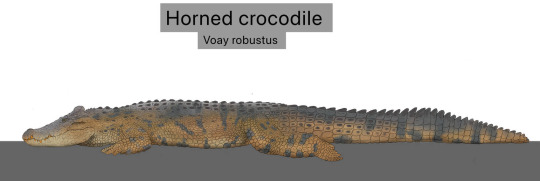

Todays fossil is a replica Voay tooth. Also known as the horned crocodile, the voay is an extinct genus of crocodilian which lived throughout swamps, rivers, wetlands, and coast regions of Madagascar until as recently as 50 A.D. It is on this massive island that the voay lineage became isolated and split off from crocodiles back in the Oligocene some 25 million years ago. Reaching upwards of 16ft (5m) in length and 500lbs (226kg) in weight the voay is the largest predator known to have roamed Madagascar since the extinction of the non avian dinosaurs and would have feed upon Fish, Birds, Amphibians, Fruit, Mammals, Invertebrates, and Other Reptiles. It sported a sorter and broader skull than most modern crocodiles with a distinctive pair of boney head crest. It also had much more robust, strongly built legs indicating that the voay likely spent almost as much time on land as it did the water. Admittedly inaccurate Toy made by creatology.
Art Belongs to the following creators:
Sobek1926: https://www.deviantart.com/sobek1926/art/Voay-robustus-the-horned-crocodile-of-Madagascar-936382947
Unenlagia90: https://www.deviantart.com/unenlagia90/art/Voay-robustus-918530868
Nixdraws: https://nixillustration.com/science-illustration/2019/voay/
#pleistocene#pleistocene pride#pliestocene pride#pliestocene#extinct#madagascar#crocodile#crocodilian#oligocene#voay#horned#horned crocodile#africa#paleontology#paleoart#cenozoic
27 notes
·
View notes
Text
Spectember D25: Ontogenetic niche shifts

Earth has recovered from a mass extinction just about 30 million years ago which would correspond to the time of the Oligocene, this version of earth happened the mass extinction of the K/Pg was delayed, so instead of ending in 66 million years ago cretaceous continued for other 30 million years until the asteroid struck down, ending the Mesozoic and so starting a new period of history of life, the delay of this mass extinction changed some aspects of evolutionary development of many groups, mammals did not became the only dominant clade in this time, many reptiles survivors have also took over, and with the short span of time that has passed to our modern times, the fauna amalgamation is a sort of reminiscence of the Eocene and even the Triassic, but cooler as the planet faced the glacial ages up to the Pleistocene.
In the ocean marine mammals are a thing of course, but they aren’t alone, Choristodere and crocodiles are also common if not predominant in the coasts and freshwater regions by a large amount, choristoderes in fact are coming in a path convergent to sauropterygians now resembling those to a big degree, with varied short body and long necked forms, predatory forms similarly to nothosaurs and very long finned forms that move across the open ocean, they have been very versatile to deal with the subsequent cooling of earth of the last 20 million years, and remain at top even with the new wave of mammals to take over the temperate and cold regions.
Among these, there are the largest coastal predators of the north hemisphere, a fully aquatic species that would look like an imitation of the Mesozoic pliosaurs, along them there are gracile fish eater forms that looks more kind to a plesiosaur, their jaws are narrower and their necks and flippers are longer, but this is no more like the juvenile of this same giant.
The Mocker Retroleviathan is a descendant of smaller choristoderes that ventured into the oceans million years before the mass extinction that already established through the extended later cretaceous thanks to the minor extinction events caused by the ecological transitions of those million years, and after the cataclysm the empty ocean left behind by the large reptiles were early claimed by these reptiles in a short time, becoming megafauna and spreading across the oceans.
The Retroleviathan is the most formidable of these, reaching up to 7 meters and weighting 2 tons, it normally feeds on different large animals including other large choristoderes, some of the piscivorous pelagic crocodilians and the increasingly large para-cetos which are derived multies that adopted fully an aquatic lifestyle resembling an archeocete with a sirenian head but with unique dentitions. They are viviparous, a female can gestate more than 10 offspring which at birth are quite independent of their parents, only being sheltered in the nearby of the territory of the adults until they reach maturity.
25 notes
·
View notes
Text
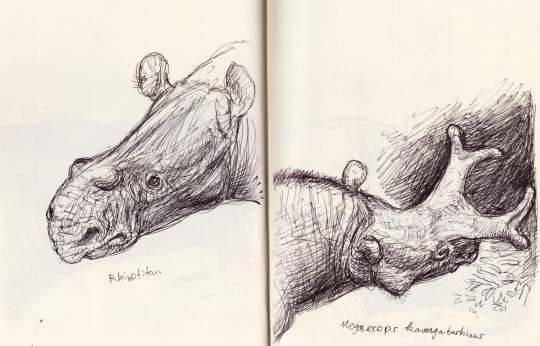


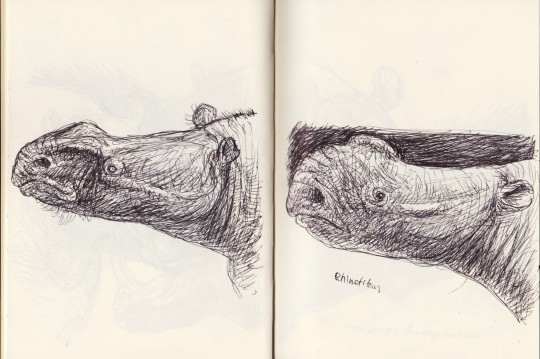

Some pages from one of my sketchbooks.
For some time I looked a little more at brontotheres, an often overlooked but beautiful and diverse group of mammals.
310 notes
·
View notes
Text
Baru: The Cleaver-Headed Crocodile
Ok back on my croc stuff, today discussing Baru. Like most the other crocs I've been talking about, Baru was a mekosuchine, a member of an endemic radiation of crocodilian native to Australasia.
Baru is easily among the largest of this group and among the most robust, with massive curved teeth and almost inflated looking jaws.
Left my interpretation of Baru darrowi, right the illustration by Willis et al. from 1990.
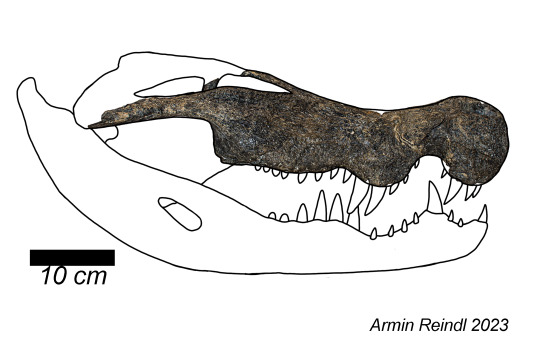

My reconstruction differs subtly in some regards, obviously the jaw material shown is from Ristevski et al. 2023 and elements of the posterior skull are based on the older Baru wickeni. My mandible also turned out slightly different, tho the quality of the images in the original description is not great so that is not guaranteed.
Anyhow, this head likely sat atop the body of what was a decently large crocodilian, with estimates suggesting four or even five meters in length for both currently recognized species Baru wickeni and Baru darrowi. As you can see below, I went for the lower estimate (which is the one given by proper publications), which still renders an immense animal all things considered, certainly holding up with many crocs of today.

Currently, there's two recognized species, one unnamed species and one that has been reassigned. The older of the named species is Baru wickeni, which was found in the Lake Eyre Basin and Riversleigh World Heritage Area during the late Oligocene. Like I already said, it was approximately as large and robust as the later Baru darrowi, but did differ in some regards. The skull had much more prominent crests, the nasal bone extended into the opening for the nares and importantly, the cutting edges of the teeth were smooth.
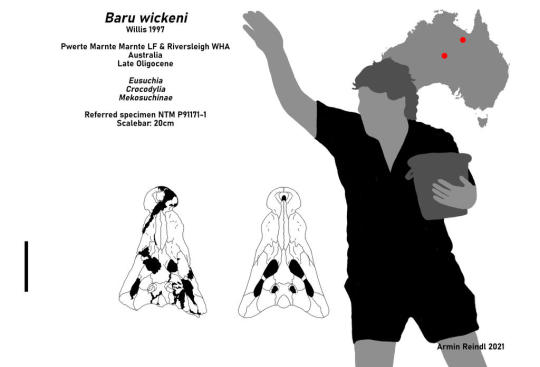
During the Miocene, Baru wickeni would be replaced by Baru darrowi, known from younger strata of the Riversleigh and the Bullock Creek fauna. Baru darrowi had less prominent crests, but in turn slight serrations on its teeth. Also the nasal bones did not extend into the nares. Baru darrowi is the species shown at the start.
The other two are then the unnamed Baru species from the Alcoota fossil site and "Baru" huberi. I talked about the latter before and how it is now thought to be something else entirely. Which leaves us with the Alcoota form. Generally regarded as a distinct species, fossils of the Alcoota Baru have been found from 2000 onwards near Alice Springs and appear to represent an animal more robust than the other known Baru. Below you can see a skeletal mount on exhibition at the Megafauna Central in Alice Springs (image by Aussie Bucket List) and a skull held by Adam Yates, an important researcher of this animal.
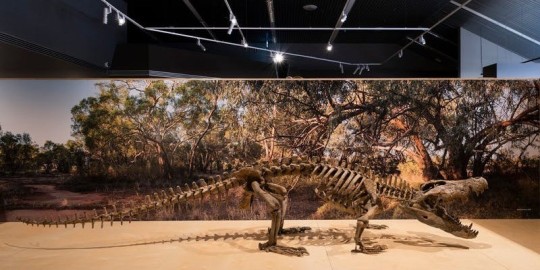
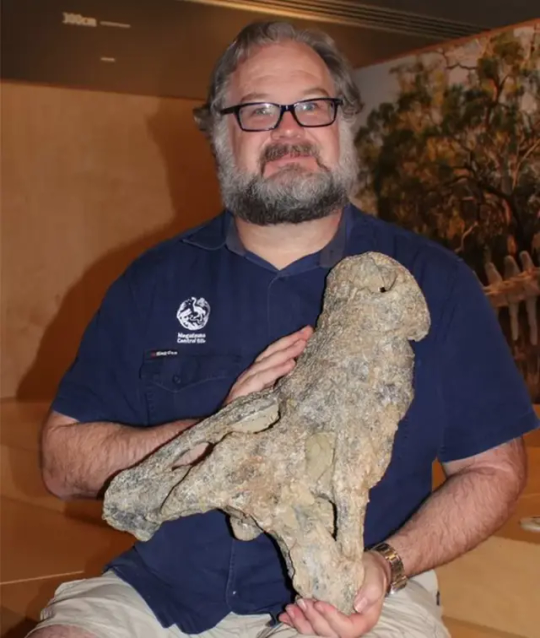
A little side note I want to mention is the name Baru. As you might have guessed from the etymology of various other mekosuchines (Kambara, Mekosuchus, Quinkana, Kalthifrons), the name actually ties into the native People of Australia. Specifically, Baru is a figure in the mythology of the East Arnhem Region, which describes him as a sort of totem crocodile that brought law to the lands he named. Baru also had a fight with Jarkitj (Willy Wagtail) after stealing fire for himself. Sadly I couldn't find much about the mythical Baru beyond a brief summary written up by George Pascoe Gaymarani you can read here.
Returning to the animal, one would suspect that the robust skull meant that it didn't quite hunt like modern crocodiles, especially considering the serrated teeth found in the younger species. Well, tho nothing concrete is known Willis and colleagues speculate that this might have been an adaptation to shallower waters. While modern crocs tend to ambush prey, grab it using a strong bite and conical teeth and then proceed to drown it, Baru may not have had that option. A modern croc can just drag a zebra for instance into deep water, weaken it and let go to adjust its grip without the risk of it getting away. In shallow waters, this may have been too risky and lead to prey escaping. So Baru's robust head and curved, sometimes serrated teeth were built to inflict a lot of damage upon prey when lunging, securing the bite and incapacitating it. Willis estimates that it may have taken prey as heavy as 300 kilos.
There's also the interesting tidbit of Baru wickeni coexisting with a diverse croc fauna, yet being conspicuously absent from more southern regions of Australia despite entering the respective drainage basin. I go into more detail while talking about Australosuchus, but the jist of it is that Baru was likely not as cold resistant as Australosuchus and thus not found as far north.
Alas, as with other mekosuchines, not much art of Baru exists aside from this absolutely fantastic piece by @knuppitalism-with-ue
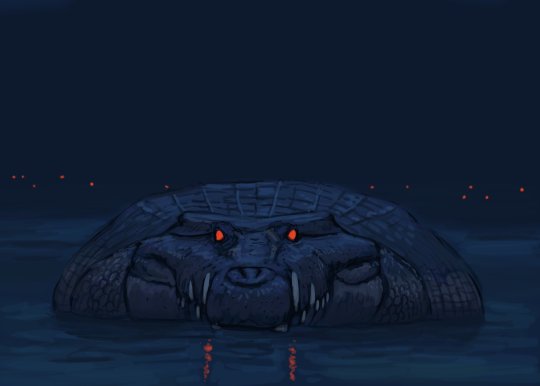
As per usual, this deep dive is brought to you as part of me redoing the wikipedia page of this genus, which resulted in a major size increase. The image below is just to show the difference, but if you want to read it here's the link: Baru - Wikipedia
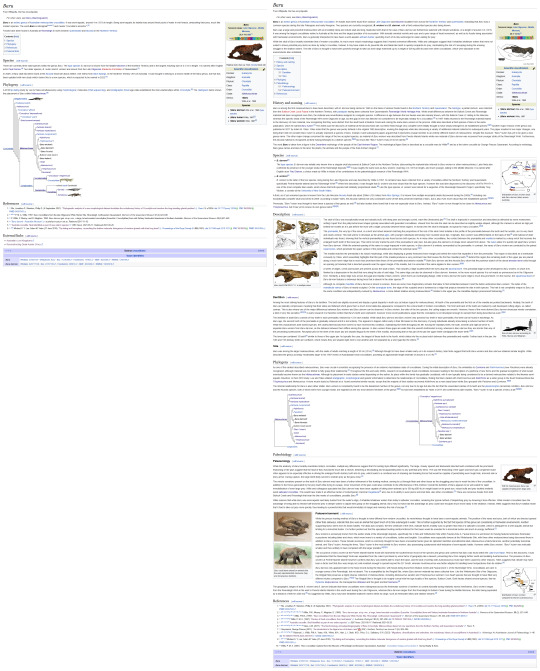
#mekosuchinae#wikipedia editing#wikipedia#baru#baru wickeni#baru darrowi#baru huberi#croc#crocodile#paleontology#palaeoblr#prehistory#oligocene#miocene#australia#long post
115 notes
·
View notes
Text
Praecarbo strigoniensis Kessler & Horváth, 2023 (new genus and species)

(Type tibiotarsus [fused shin and ankle bones] of Praecarbo strigoniensis, from Kessler and Horváth, 2023)
Meaning of name: Praecarbo = before [in Latin] Carbo [defunct genus name for the great cormorant, now in the genus Phalacrocorax]; strigoniensis = from Esztergom
Age: Oligocene (Rupelian–Chattian)
Where found: Mányi Formation, Komárom-Esztergom, Hungary
How much is known: The tip of a right tibiotarsus (fused shin and ankle bones).
Notes: Praecarbo appears to have been a cormorant, a group of waterbirds that primarily catch prey by swimming underwater, propelling themselves with their feet. If correctly identified, Praecarbo would be one of the oldest cormorants known.
Reference: Kessler, J. and I. Horváth. 2023. Praecarbo strigoniensis, a new genus and species of cormorants (Phalacrocoracinae) from the Late Oligocene of Hungary. Ornis Hungarica 31: 126–132. doi: 10.2478/orhu-2023-0008
35 notes
·
View notes
Text
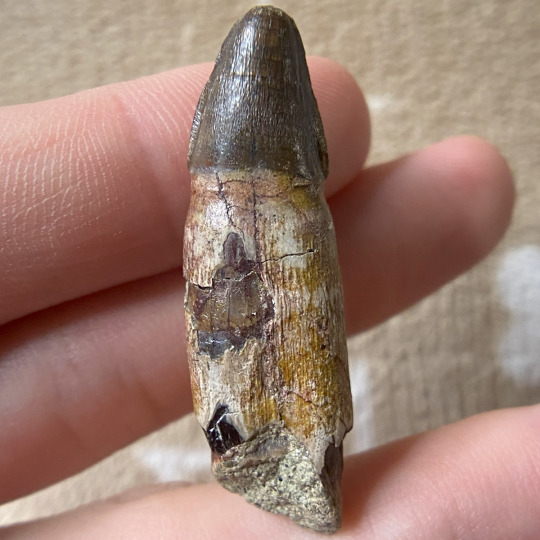
A fossilized rooted crocodilian tooth of an Alligator prenasalis from the Brule Formation in Custer County, South Dakota, United States. This Paleogene aged species of alligatorine is currently the oldest occurrence of the genus Alligator.
#crocodylomorpha#crocodilian#fossils#paleontology#palaeontology#paleo#palaeo#alligator#eusuchia#oligocene#cenozoic#science#prehistoric#paleoblr#アリゲーター#正鰐類#ワニ#化石#古生物学
8 notes
·
View notes
Text

Delicious, nutritious sunbaked Paraceratherium corpse! With Hyaenodon and Generic Vultures.
#vulture#palaeoblr#paleoblr#paleoart#palaeoart#paraceratherium#oligocene#paleontology#hyaenodon#yee art
134 notes
·
View notes